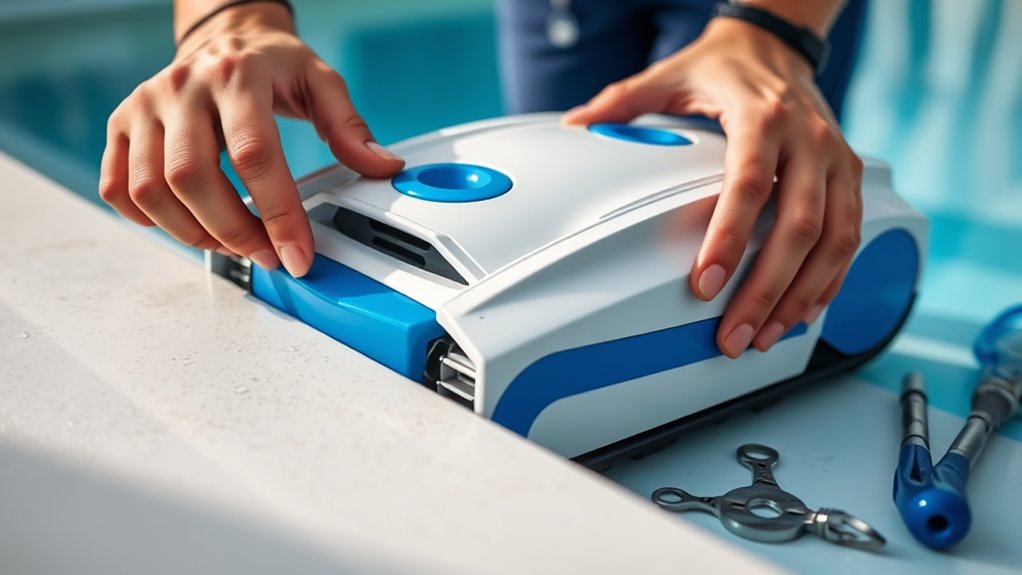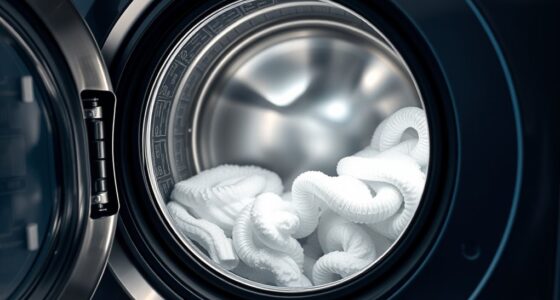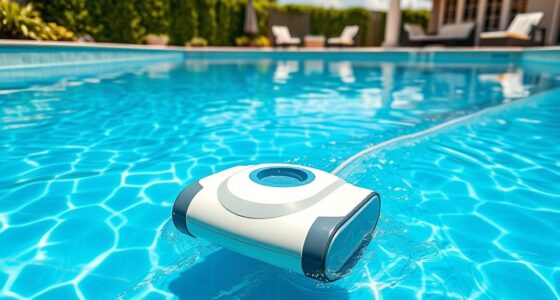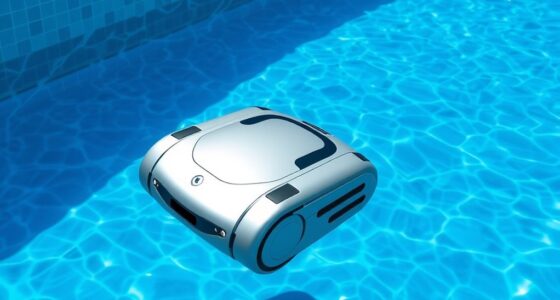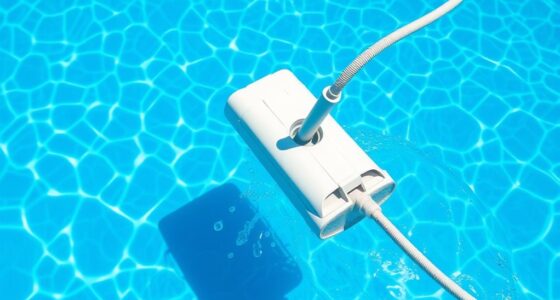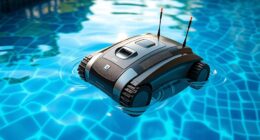To keep your robotic pool cleaner running smoothly, regularly check and clean the filter weekly, replacing it as needed. Remove the device from the charger after each use and store it in a cool, dry place. Inspect moving parts like brushes and wheels for wear, cleaning out tangled hair or debris. Keep the body and sensors clean to ensure efficient operation. Consistent maintenance helps extend its lifespan, and if you want detailed tips, there’s more to explore.
Key Takeaways
- Regularly clean and replace the filter to maintain debris pickup efficiency and prevent clogging.
- Inspect and clean moving parts like brushes and wheels to prevent wear and ensure smooth operation.
- Remove the device from the charger after each use and store it in a cool, dry place to preserve battery health.
- Check for debris buildup on external components and wipe down the device for optimal performance.
- Establish a routine schedule for maintenance tasks to extend the device’s lifespan and prevent costly repairs.

Regular maintenance is essential to keep your robotic pool cleaner operating efficiently and lasting longer. When you stay on top of routine checks, you prevent small issues from turning into costly repairs and ensure your cleaner performs at its best. One of the most important aspects of maintenance is keeping the filter clean and replacing it when necessary. Over time, debris, dirt, and algae can clog the filter, reducing suction power and overall cleaning efficiency. Regular filter replacement or cleaning allows your device to operate smoothly, saving you time and energy in the long run. Depending on usage and water conditions, you should check the filter weekly and replace it every few months, or as recommended by the manufacturer. A clean filter means better debris pickup and less strain on the motor, which directly impacts the device’s lifespan.
Alongside filter maintenance, battery upkeep plays a crucial role in maintaining your robotic pool cleaner’s performance. Properly caring for the battery ensures it holds a good charge and operates safely. After each cleaning session, make sure to remove the device from the charger and store the battery in a cool, dry place. Avoid leaving the battery fully drained or constantly plugged in, as both habits can shorten its lifespan. Occasionally, check the battery contacts for corrosion or dirt, and clean them gently if needed. If your cleaner uses a rechargeable lithium-ion battery, follow the manufacturer’s guidelines for charging cycles; overcharging or undercharging can diminish the battery’s capacity over time. If you notice your device isn’t holding a charge like it used to, it might be time to replace the battery. Regularly inspecting and maintaining the battery ensures your cleaner will be ready to go whenever you need it, preventing unexpected downtime. Additionally, understanding the regulatory standards for battery safety can help you avoid potential hazards and ensure compliance with local laws. Staying informed about battery safety regulations can also help you select the right replacement parts and avoid legal issues.
Furthermore, routine maintenance involves inspecting the brushes and wheels for wear and tear, ensuring there’s no tangled hair or debris around moving parts. Wiping down the body and sensors keeps the device operating smoothly and accurately. Keeping the filter and other components free of debris buildup helps maintain optimal performance. Regularly checking and replacing worn parts can prevent more serious damage and costly repairs down the line. Keep in mind that consistent cleaning and timely replacement of worn parts extend the life of your robotic cleaner. Remember, staying proactive with filter replacement and battery upkeep isn’t just about performance; it’s about protecting your investment. When you give your robotic pool cleaner the care it needs, it rewards you with efficient, reliable cleaning and a longer service life. Proper color accuracy in your device can also enhance your overall cleaning results, especially if it uses visual sensors for navigation. By establishing a simple maintenance routine, you’ll enjoy a sparkling pool with less hassle and more confidence in your device’s ability to handle the job.
Frequently Asked Questions
How Often Should I Replace the Robotic Pool Cleaner’s Brushes?
You should replace your robotic pool cleaner’s brushes when you notice signs of wear or damage, typically every 6 to 12 months. Regular brush replacement guarantees peak cleaning performance and extends the device’s lifespan. Keep an eye on the brushes and perform regular cleaning to maintain their effectiveness. Adjust your cleaning frequency based on your pool’s usage and debris levels to keep your cleaner functioning smoothly.
Can I Use Household Cleaners to Maintain My Robotic Pool Cleaner?
It’s a coincidence you ask about household cleaners, as many overlook household chemical safety when maintaining their robotic pool cleaner. You shouldn’t use DIY cleaning solutions or household chemicals because they can damage the device’s delicate parts. Stick to manufacturer-approved cleaning methods, using only water and gentle brushes. This guarantees your robotic cleaner stays in top condition, avoiding corrosion or malfunction caused by harsh chemicals.
What Is the Recommended Storage Method During Off-Season Months?
For seasonal storage during the off-season, you should clean your robotic pool cleaner thoroughly and remove any debris. Store it in a dry, cool place away from direct sunlight, ideally in a dedicated storage container or bag. Follow off-season tips by disconnecting the power supply and avoiding damp areas. Proper seasonal storage guarantees your cleaner stays in good condition and is ready to use when swimming season returns.
How Do I Troubleshoot if the Cleaner Gets Stuck Frequently?
If your robotic pool cleaner keeps getting stuck, start troubleshooting by checking for sensor calibration issues, as dirty or misaligned sensors can cause it to halt. Also, inspect the power supply for any issues, such as loose connections or insufficient power. Make sure the brushes and wheels are clear of debris. Regularly cleaning sensors and ensuring a stable power source help your cleaner run smoothly and avoid frequent getting stuck.
Are There Specific Filters Suitable for Different Pool Types?
When choosing filters, you should consider filter compatibility and pool type suitability. Different pool types, like above-ground or in-ground, require specific filters that fit your robotic cleaner. Check the manufacturer’s guidelines to guarantee the filter you pick matches your cleaner and pool. Using the right filter ensures ideal performance and longevity. Always verify compatibility to avoid damage and keep your robotic pool cleaner working efficiently.
Conclusion
Think of routine maintenance as the heartbeat of your robotic pool cleaner. When you keep it in check, your cleaner runs smoothly, just like a well-tuned instrument. Neglecting it can lead to breakdowns, turning your sparkling pool into a cloudy chaos. Regular care is your best defense, ensuring your cleaner stays reliable and efficient. By nurturing your device, you’re not just maintaining equipment — you’re safeguarding your oasis, turning pool cleaning into a seamless dance rather than a chore.
